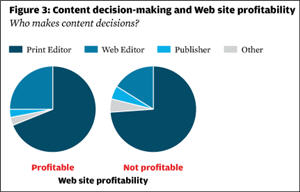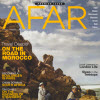By Michael Gold on January 23, 2012
How Esquire Survived Publishing’s Dark Days (NY Times)
Kindle Fire is disappointing: Usability guru Jakob Nielsen says it offers “a disappointingly poor user experience.” (Useit.com)
How Apple Changes Education, Forever: Apple’s plan to bring iPad textbooks to schools across America and around the world via iBooks 2 and iBooks Author is nothing short of a revolution. (Mashable)
Cashing In on Your Hit YouTube Video: Should you monetize your family? Or maybe just enjoy these user-generated videos.
Posted in Magazines, Notable, Usability, User-Generated Content, Video, Web Publishing
By Susan West on October 7, 2011
 A couple of weeks ago, I was in Asheville, North Carolina, talking with lots of smart women in publishing about the state of the industry—and where we all might go from here.
A couple of weeks ago, I was in Asheville, North Carolina, talking with lots of smart women in publishing about the state of the industry—and where we all might go from here.
I joined a panel moderated by Elissa Yancey, who is a journalism prof at the University of Cincinnati and managing editor of Soapbox Media, that included Susan Mernit, founder of Oakland Local, and Lisa Carricaburu, the assistant managing editor of the Salt Lake Tribune.
First of all, if you don’t know about Journalism and Women Symposium (I didn’t), you should. I don’t think I’ve ever been around a more inspiring, thoughtful, and tuned-in group of journalists—or women—in my life. Check ’em out.
But back to the panel: These women are right in the thick of things, creating and trying out and shaping all the new options publishing offers. At the Salt Lake Tribune, Carricaburu has learned to be fast, adaptable, and strategic: Blogs that don’t draw traffic get dropped quickly, for example, and putting public records in a searchable database has turned out to a gold mine, both for reporters and readers—and therefore for the paper. Mernit and Oakland Local are at the heart of the hyperlocal news movement, supporting street-smart reporting with social media and employing tools like visual storytelling. Yancey teaches her students what she learns on the job.
No one on the panel said the future will be easy, but everyone said it’s sure to be interesting. Read the highlights of our discussion and see if you agree.
Posted in Conferences & Classes, Future of Publishing
By Susan West & Michael Gold on May 16, 2010
iPad usability: First findings from user testing: iPad apps commit some of the same errors as early Web sites, says Jakob Nielsen’s first report on the device’s usability, including confusing navigation interfaces and inconsistent interactions. (Nielsen’s Alertbox)
How to save the news: James Fallows says Google is the problem, er, the savior. (The Atlantic)
New Consumer Reports mobile website offers complete Ratings: In a smart move, Consumer Reports now allows users to tap into all the latest ratings wherever they are, free with a subscription to the main site or $5 per month. (ConsumerReports.org)
Putting a price on words: A primer in entrepreneurial online journalism models, where search and demand set the fees paid to contributors. (New York Times)
Posted in Digital Magazines, Magazines, Mobile, Newspapers, Notable, Usability
By Susan West on March 31, 2010
 In the conclusion of Columbia Journalism Review’s recent study, “Magazines and Their Web Sites,” the authors ask:
In the conclusion of Columbia Journalism Review’s recent study, “Magazines and Their Web Sites,” the authors ask:
“What are the deepest implications of the finding that when a Web editor is in charge of both budget and content decisions, that traffic and revenue increase but quality and ethical standards decrease?”
That question made us go back and take a closer look at the study’s findings about sites run by Web-only editors.
These findings were widely reported:
- Magazine websites are more likely to be profitable and have higher traffic if an independent Web editor is in charge of the budget and content.
- Magazines with independent Web editors in charge of content decisions are about twice as likely to have a less rigorous fact-checking process for Web content than magazine editors have for print content, and almost three times as likely to have no fact-checking at all.
- Web editors who are in charge of content decisions are more likely to correct errors on their site, but they are also less likely to notify users of the corrections.
But these findings–equally interesting, if not more so–were less widely reported:
- When independent Web editors are in charge of online content, there is a greater tendency to have separate, dedicated staffs for print and Web, rather than a staff expected to work in both media.
- When independent Web editors are in charge of budgets, their sites are more likely to have a dedicated Web advertising team than when print editors or publishers are in charge.
- Magazine websites are more likely to have blogs when independent Web editors are in charge of the budget.
- When independent Web editors are in charge of budget or content decisions, their sites are more likely to have or include digital editions, RSS, podcasts, and versions of the site designed for mobile phones and e-books.
In other words, sites run by Web-only types are more likely to focus on and take full advantage of a digital approach—to be more Web-native. Which may be one reason why those sites have more traffic and are more profitable.
Yes, fact-checking is important. But the survey didn’t examine whether lower standards affect accuracy; newspapers, after all, traditionally have not used fact-checkers. What’s more, standards of fact-checking can easily be addressed–while successful strategies for online advertising, digital extensions, traffic growth, and profitability are way harder to come by.
Mind you, we strongly advocate collaboration and communication between the print and digital sides of a magazine or media company. But these findings suggest that for a magazine to find its voice online, it needs dedicated, online-only managers and thinkers.
So here’s our answer to CJR’s question: The deepest implication seems to be that a Web-only editor can make a magazine’s site the forward-looking, digital native it needs to be in order to succeed. If there’s a choice, why hire anyone else?
Do you agree? Disagree? Please leave a comment and let us know.
Posted in Digital Magazines, Magazines |
By Susan West & Michael Gold on March 27, 2010
Scrolling behavior and users’ attention: Research from the Nielsen Norman group shows that, although users do scroll, they spend 80% of their time looking at information “above the fold.” (Nielsen’s Alertbox)
MPA’s catalog of magazine apps: A constantly updated compendium of mobile applications produced by magazines and media companies. (MPA)
Social media presence is now a journalism job performance metric:Twitter is part of the job for most journalists these days. (Village Voice)
How magazines use social media to boost pass-along and build voice: Examples from Seventeen, Lapham’s Quarterly, Sunset and others. (MediaShift)
The iPad could revitalize story-telling: Or not, depending on whether publishers push the boundaries, says E-Media Tidbits’ Steve Myers. (Poynter Online)
Posted in Magazines, Mobile, Notable, Social Media, Usability
By Susan West & Michael Gold on March 20, 2010
ABC Redefines Digital Magazine: Planning for the move from print to digital e-reading devices, the Audit Bureau of Circulations has expanded its definition
of a digital magazine (though it may still be too narrow). (Media Week)
Print Your Own Newspaper: The Newspaper Club, a London-based online start-up, enables anyone to print a customized 12-page newspaper. (BBC News)
Society of Professional Journalists Digital Media Handbook, Part I: Practical advice on everything from using social media as reporting tools to creating slide shows, interactive time lines, and better video. (Scribd)
The Future of Publishing–a Surprising Video: A very cool presentation by book publisher DK/Penguin. Be sure to watch to at least the halfway point. (Penguin)
10 Tips for Launching Almost Anything: Susan West, who spent the last year launching Afar magazine, offers useful guidelines for starting a magazine, a story, a writing career, etc. (West Gold Editorial)
Successful Site Redesign: Nine steps for a smooth, successful revamping of your website. (West Gold Editorial)
Posted in Digital Magazines, Magazines, Newspapers, Notable
By Susan West on March 19, 2010
 When it comes to magazines’ companion websites, most thoughtful publishers have successfully solved the “shovelware”
When it comes to magazines’ companion websites, most thoughtful publishers have successfully solved the “shovelware”
problem–they no longer just dump their content online. Instead,
the better magazine-related sites have become useful, interactive entities in
their own right, offering Web-native experiences. (Even if no one is paying to have that experience.)
Now, with the advent
of the iPad and other tablets and e-readers, publishers are facing the
same issue all over again. The tablet, with its touch screen and rich color, is “magazine-like.” But it’s not a magazine; this is another new medium, with its own native experience. A tablet edition will be–or should be–different from a print edition and different from a companion website.
Publishers are just starting to ponder this. We think it means taking a hard look at your editorial strategy and identity, and deciding what works best in each medium. Maybe you’ll discover that the tablet and/or a website, not print, are the best media for your brand. How are you sorting this out?
Posted in Content Strategy
By Susan West on March 15, 2010
 My Smithsonian pal Beth Py-Lieberman hipped me to a piece from Time magazine about Demand Media, which is a “content farm” that uses the Web’s most popular search terms to decide which topics to cover (hence “demand”). The company’s thousands of freelance writers–many of them newly unemployed, top-notch journalists–are paid just pennies per word to crank out articles such as “How to remove dents in a hair dryer” and “How do I donate a car in Dallas?” Editing and fact-checking are minimal. The pieces end up on Demand Media’s popular sites eHow.com and Livestrong.com, as well as in print outlets such as the Atlanta Journal-Constitution. Demand is valued at $1.3 billion.
My Smithsonian pal Beth Py-Lieberman hipped me to a piece from Time magazine about Demand Media, which is a “content farm” that uses the Web’s most popular search terms to decide which topics to cover (hence “demand”). The company’s thousands of freelance writers–many of them newly unemployed, top-notch journalists–are paid just pennies per word to crank out articles such as “How to remove dents in a hair dryer” and “How do I donate a car in Dallas?” Editing and fact-checking are minimal. The pieces end up on Demand Media’s popular sites eHow.com and Livestrong.com, as well as in print outlets such as the Atlanta Journal-Constitution. Demand is valued at $1.3 billion.
The Time piece got me thinking about the debate over farmed vs wild-caught fish, and how journalism/content production seems to be in a similar fix: Sure, the farmed stuff meets the market demand, but it’s less tasty, less nutritious, more likely to be tainted, and may threaten wild stock. What happens to “wild-caught” journalism–investigative stories and unexpected, richly reported narratives that take months of research and dedicated work by writer, editors, and fact-checkers–when farmed content floods the market?
Take NYU’s nominees for The Top Ten Works of Journalism of the Decade. These stories, many of which you’ll recognize as news-breaking and ground-shaking, are the result of curiosity, dedication, and independent thinking. The topics they cover may end up among popular search terms, but they didn’t start out that way. And many of the news organizations that published these stories are struggling to survive.
What do you think? Does farmed content threaten wild-caught journalism? Or is there room for both?
Posted in Newspapers, Search, Writing & Editing
By Susan West on March 15, 2010

Tip #6: Entertain yourself (as we did in inventing departments for Afar magazine).
Recently I spoke to a meeting of the Left Coast Writers at the Book Passage in Corte Madera, California. The topic was “How to Launch—a magazine, a story, a writing career…whatever.” Below, in a nutshell, are my 10 tips.
If you’re interested in more detail, feel free to download a PDF version of my full presentation, which is based in part on the process we went through in launching Afar magazine. And, if you’re launching something right now, or you just finished, let me know if you have any tips you’d like to share.
How to Launch Anything
- Size up the competition
- Picture your audience
- Clarify your goals
- Build a clear structure
- Use specifics
- Entertain yourself (but don’t indulge)
- Show your passion
- Maintain flexibility
- Zoom in, zoom out
- Check your gut
Download PDF: 10 Tips for Launching
Posted in Books, Magazines, Resources, Web Publishing
By Susan West & Michael Gold on March 13, 2010
Five Basic Things Authors Should Do Online: Good advice to help writers (and others!) get started in social media, with links to valuable resources. (52 Projects)
Six Ways to Stop the Social Media Madness: In case you're tempted to overdo it, here are tips on how to control the urge. (Web Worker Daily)
How to use Twitter as an SEO research tool: This video shows how Twitter can help you time the release of your content so it's likely to score high in search results. (SEOMoz)
Potential investors think Pandora could go public: The popular internet radio site has been on the verge of death for 10 years. Now it's the darling of investment bankers. (NYTimes)
Complete list of 2010 National Magazine Award nominees (ASME)
Posted in Magazines, Marketing, Notable, Search, Social Media






